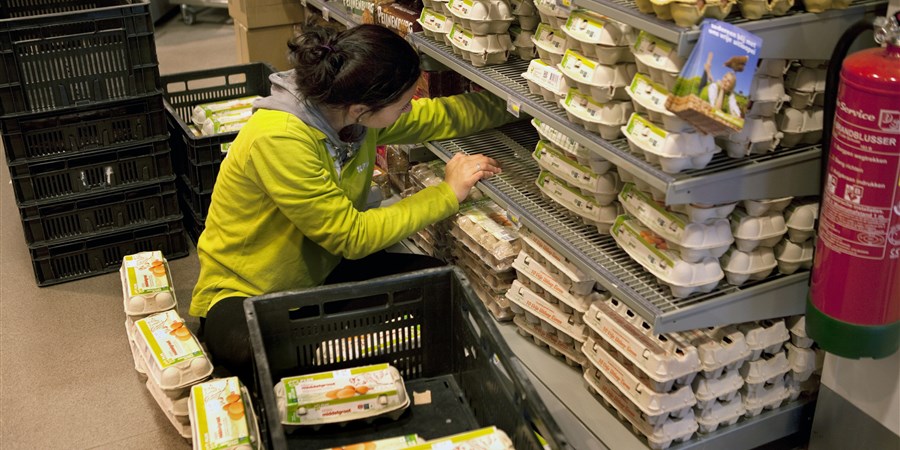Inflation at 3.8 percent in February according to flash estimate
More recent figures are available on this topic. View the latest figures here.

The regular consumer price index (CPI) figures for February will be published on 11 March.
| year | month | Inflation (year-on-year % change of the CPI) |
|---|---|---|
| 2020 | January | 1.8 |
| 2020 | February | 1.6 |
| 2020 | March | 1.4 |
| 2020 | April | 1.2 |
| 2020 | May | 1.2 |
| 2020 | June | 1.6 |
| 2020 | July | 1.7 |
| 2020 | August | 0.7 |
| 2020 | September | 1.1 |
| 2020 | October | 1.2 |
| 2020 | November | 0.8 |
| 2020 | December | 1.0 |
| 2021 | January | 1.6 |
| 2021 | February | 1.8 |
| 2021 | March | 1.9 |
| 2021 | April | 1.9 |
| 2021 | May | 2.1 |
| 2021 | June | 2.0 |
| 2021 | July | 1.4 |
| 2021 | August | 2.4 |
| 2021 | September | 2.7 |
| 2021 | October | 3.4 |
| 2021 | November | 5.2 |
| 2021 | December | 5.7 |
| 2022 | January | 6.4 |
| 2022 | February | 6.2 |
| 2022 | March | 9.7 |
| 2022 | April | 9.6 |
| 2022 | May | 8.8 |
| 2022 | June | 8.6 |
| 2022 | July | 10.3 |
| 2022 | August | 12.0 |
| 2022 | September | 14.5 |
| 2022 | October | 14.3 |
| 2022 | November | 9.9 |
| 2022 | December | 9.6 |
| 2023 | January | 7.6 |
| 2023 | February | 8.0 |
| 2023 | March | 4.4 |
| 2023 | April | 5.2 |
| 2023 | May | 6.1 |
| 2023 | June | 5.7 |
| 2023 | July | 4.6 |
| 2023 | August | 3.0 |
| 2023 | September | 0.2 |
| 2023 | October | -0.4 |
| 2023 | November | 1.6 |
| 2023 | December | 1.2 |
| 2024 | January | 3.2 |
| 2024 | February | 2.8 |
| 2024 | March | 3.1 |
| 2024 | April | 2.7 |
| 2024 | May | 2.7 |
| 2024 | June | 3.2 |
| 2024 | July | 3.7 |
| 2024 | August | 3.6 |
| 2024 | September | 3.5 |
| 2024 | October | 3.5 |
| 2024 | November | 4.0 |
| 2024 | December | 4.1 |
| 2025 | January | 3.3 |
| 2025 | February | 3.8 |
Short-term price trends
The CPI not only provides an insight into price changes relative to one year previously (the CPI inflation rate), but also changes relative to the previous month. According to the flash estimate, consumer prices rose by 1.1 percent in February 2025 relative to January 2025.It should be noted that when comparing two different months in the same year, seasonal influences must be taken into account. For example, airline tickets are more expensive in holiday months than outside the holiday season. These higher prices are temporary rather than structural, however. Month-on-month changes are often more volatile than year-on-year changes as a result of seasonal influences like this.
Price changes across various product groups
In addition to the inflation rate, CBS also publishes price changes for a number of product groups as part of its flash estimate. These product groups are broad spending categories, such as ‘all services’. The price changes for all the categories in the CPI will be published on 11 March.| February 2025 (%) | January 2025 (%) | |
|---|---|---|
| All items | 3.8 | 3.3 |
| Non-energy industrial goods | 1.5 | 0.3 |
| Energy including motor fuels | -1.9 | -1.4 |
| Food, beverages and tobacco | 7.5 | 7.0 |
| Services | 4.6 | 4.4 |
HICP flash estimate
CBS publishes two different figures for inflation. One is based on the Consumer Price Index (CPI) and the other on the European Harmonised Index of Consumer Prices (HICP). According to the HICP flash estimate, inflation stood at 3.5 percent in February. In January 2025, it stood at 3.0 percent.In order to facilitate comparison between countries, EU member states calculate their consumer price indices according to internationally agreed definitions and methods. Eurostat uses the HICP figures from all EU countries to calculate the inflation rate for the euro area and the European Union. The European Central Bank (ECB) uses the HICP to formulate its monetary policies for the euro area. In addition, most countries publish a national consumer price index.
In the case of the Netherlands, the main difference between the CPI and the HICP is that the HICP does not take account of costs related to home ownership, while the CPI does. In the CPI, these costs are calculated based on changes in rents for housing. However, this is not the only difference. The differences are explained in greater detail in the article linked below.
Sources
- StatLine CPI - Consumer prices; price index 2015=100
- StatLine HICP - Consumer prices; European harmonised price index 2015=100 (HICP)
- Article - Flash estimate of the consumer price index (CPI)
- Article - Differences between consumer price figures
- Table - Research series consumer price index electricity and gas
Related items
- Dossier - Business cycle